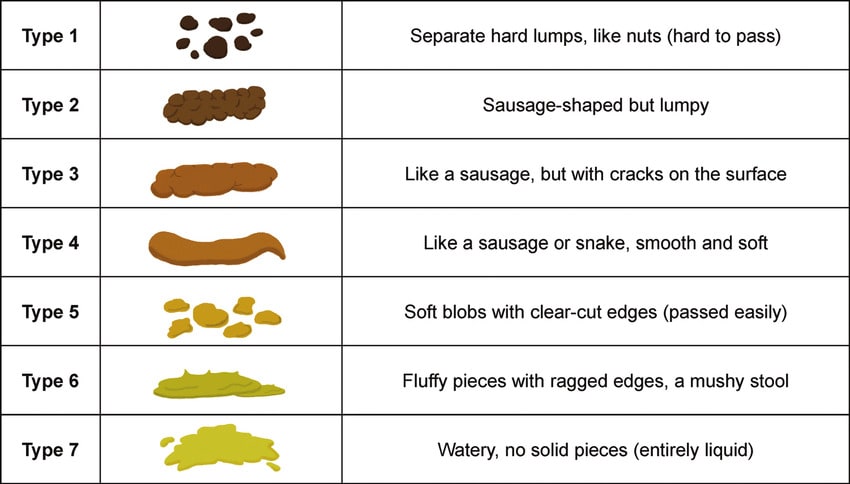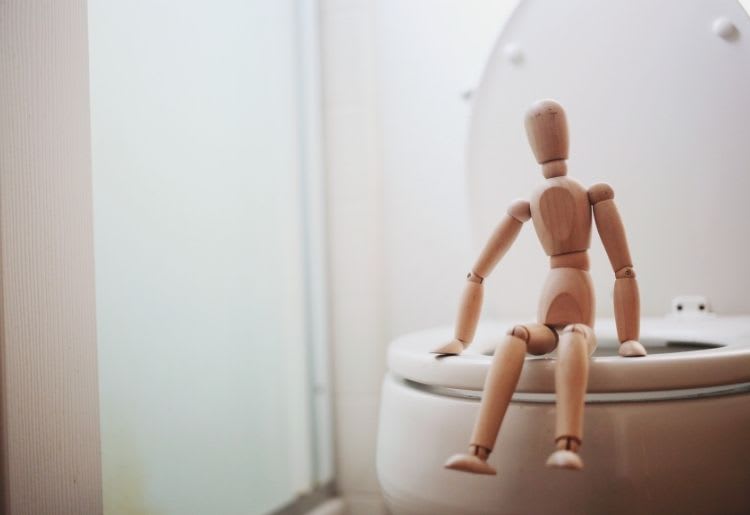The gut is our gatekeeper for health and keeping a healthy gut is vital for our wellbeing. A healthy gut supports the immune system, helps with brain function, and is the primary place where we get our nutrients.
If you learn how to read the signs your poop is giving you, you can understand what your poop says about your health and make the necessary changes to lead a healthier lifestyle. If you feel that you don't have the time or knowledge to develop a healthy meal plan, there are plenty of meal delivery services such as BistroMD that help change bad habits for a healthier lifestyle
What is Normal Poop?
A normal poop is brown, with a soft consistency, and is easy to pass. However, there is a range of “normal” in terms of poop color, size, and shape.
When it comes to assessing what is normal for you, consider whether there are any recent changes to the color, shape, size, and consistency of your poop.
Color
Though brown is considered the standard color, your stool color may vary based on foods you’ve eaten or even certain health issues you may be facing, including if you’ve recently been sick.
Gastroenterologists, or digestive health doctors, will assure you that shades of brown and green are generally considered normal. Poop’s brown color is primarily a combination of bilirubin and bile, both of which are orange to yellow in color.
Shape
Your poop’s shape can indicate how hydrated you are and how much fiber you’re getting in your diet. Normal-shaped poop can range from a log with cracked edges to a smooth snake.
Use the Bristol Stool scale further down in this article to assess your poop’s shape.
Size
A typical stool size is at least one to three inches in length and most importantly, should be easy to pass.
For example, if you have a stool that is a normal length, but is difficult to pass, then it suggests you are dehydrated and/or lacking fiber in your diet.
Consistency
Healthy poop consistency is soft, but firm poop that is easy to pass is also considered normal. Poop that is very hard or misshapen and overly soft can indicate an underlying health issue.
How Long it Takes
An extended bathroom break could mean you are constipated, which means bowel movements may be less frequent and require more effort. For instance, you might be constipated if you have difficult bowel movements or if you feel like not all the stool has passed.
A healthy bowel movement shouldn’t take more than a few minutes to pass.
How Often
It’s okay not to have a bowel movement every single day, but if you are having less than three bowel movements per week, that is an indicator of constipation.
It might also surprise you that having up to three bowel movements per day is also considered normal, provided the color, shape, and consistency are typical as well.
What is the Bristol Stool Scale?
The Bristol Stool Scale is a helpful and effective visual guide that depicts a stool's transit time in the gut. For most people, transit time through the colon is 30 to 40 hours, though up to 72 hours is considered typical.

Below are the 7 types of stools on the Bristol Stool Scale, including what they look like, what this may indicate, and what to eat to help improve the health of your poop.
Type 1
Appearance: Hard, lumpy pieces, like acorns that are difficult to pass.
What it indicates: Severe constipation. Your stool has a slow transit, meaning it has spent a long time in your colon.
What you should eat: Drink adequate fluids and decrease high-fat foods, especially animal fats. Adding fiber-rich foods such as fruits, vegetables, beans, and whole grains will help stool move through the colon faster and have a softer consistency.
Type 2
Appearance: Sausage-shaped, but lumpy.
What it indicates: Type 2 stools can be difficult to pass and are an indication of constipation.
What you should eat: Fiber and water are the winning combination for combating constipation. Most adults need between 25 and 35 grams of fiber per day, which is roughly equivalent to 5 servings of fruits and vegetables.
Type 3
Appearance: Soft, easy to pass, and shaped like a sausage, but with cracks on the surface.
What it indicates: Digestive experts agree that type 3 stools are normal.
What you should eat: Continue eating and drinking the foods that result in healthy, regular bowel movements. Also, regular physical activity and managing stress assist in keeping your digestive health in good standing.
Type 4
Appearance: Soft, shaped like a smooth sausage or snake.
What it indicates: If your poop looks like type 4, great news, some experts think this is ideal.
What you should eat: Keep getting the right mix of carbohydrates, protein, fat, fiber, and water.
Type 5
Appearance: Soft blobs with clear-cut edges that pass easily.
What it indicates: Normal, though type 5 stools can be a sign of mild diarrhea. If you have a sense of urgency with this type of stool, it could indicate that it is diarrhea, but will likely clear within a few days.
What you should eat: Continue to eat a variety of foods including lean protein or beans, vegetables, fruits, whole grains, nuts, and healthy fats.
Type 6
Appearance: Mushy stools with fluffy pieces and ragged edges.
What it indicates: Diarrhea. There is no mistaking the problematic urgency with type 6 stools.
What you should eat: Most cases of mild diarrhea will clear on their own in a few days. The most pressing issue is to replace the fluids you are losing, so focus first on consuming plenty of water. Small, frequent meals of bland foods that you can tolerate are recommended until symptoms start to improve. Stress can also trigger diarrhea so be sure to find an outlet that helps you manage stress.
Type 7
Appearance: Watery, no solid pieces, entirely liquid diarrhea.
What it indicates: Diarrhea. This type of unpleasant diarrhea moves through the gut quickly and can have multiple causes including bacterial infection, viruses, or parasites.
What you should eat: Replacing fluids and electrolytes with type 7 diarrhea is essential. Finding foods that have sodium and potassium. These electrolytes are found in foods such as broths, soups, bananas, applesauce. Avoid high fat and high sugar foods until your gut heals. If you have more than three type 7 stools in a day for more than two days, it’s recommended to see a medical provider.
What Does a Your Poop Color Mean?
Poop doesn’t have to be brown to be normal. Foods and medications can influence poop’s color. Different-colored poop could indicate a medical problem, so let’s explore what certain colors mean.
Black
What it indicates: Taking iron supplements or eating black licorice can turn your poop black. However, bleeding in the upper GI tract, cirrhosis, or colon cancer can cause black poop, so don’t ignore its presence.
What you should eat: If you aren’t supplementing with iron or consuming licorice, contact your doctor as this is a sign of a potentially serious problem.
Green
What it indicates: Eating lots of leafy greens or green food coloring can cause a green poop hue, which is normal.
What you should eat: If the green color persists and you are concerned about potential diarrhea, contact your medical provider.
Pale, White, or Clay-Colored
What it indicates: Anti-diarrhea and other medications may cause this color poop. If you are not taking medications, light pale, white- or clay-colored poop is problematic and typically is the result of a bile obstruction.
What you should eat: If the light color persists, and if you are not taking medication, contact a medical provider.
Red
What it indicates: Bright red blood in stools is most frequently a sign of hemorrhoids. Otherwise, red stools can be caused by consuming red foods such as beets, red food dye, cranberries, and red drinks.
What you should eat: Discontinue consuming red foods and drinks to see if the symptoms pass. If you suspect hemorrhoids are the cause, increasing your fiber and water will help soften stools.
Yellow
What it indicates: Eating too many orange foods can turn stool yellow. Yellow stools that are greasy and foul-smelling can mean there is excess fat in the stool, likely caused by a gut disorder.
What you should eat: Try eliminating orange foods such as sweet potatoes, carrots, turmeric, and yellow food coloring to see if the color fades. If the color persists, contact your medical provider.
What Does it Mean When Your Poop Floats?
Sometimes poop floats. Poop will float for the same reason any object will float in water, it is less dense than water. The amount of gas that your foods produce affects the density of your poop. Your gut’s microflora consists of 100 trillion bacteria eager to ferment the food you eat.
Some foods produce more gas than others and fiber is the key. High-fiber foods, such as fruits and vegetables, produce gas in your gut. That gas gets trapped in your poop. If there is enough gas trapped inside your poop, it will float in the toilet bowl water.
Floating stools can suggest a potential problem. If your body isn’t absorbing fat properly, it will get excreted and the fat will cause your poop to float. If you suspect this is the case, it is best to discuss it with a medical provider.
When Should You See a Doctor?
For preventative health, all adults over the age of 45 should schedule a colonoscopy to visually inspect their colon health.
If you suspect that your poop might be abnormal, don’t be shy and speak up to your physician. Catching gut health problems early is essential.
Takeaway
Our bodies are beautifully designed to give us feedback on our health if we pay close enough attention to what they’re saying. The color, size, shape, and consistency of your poop give you clues about gut transit time, adequate nutrition, hydration status, or any potential problems.
Now that you know what your poop says about your health, be sure to check the toilet before you flush. Reference the Bristol Stool Scale and color guide to easily monitor your gut health at home.
